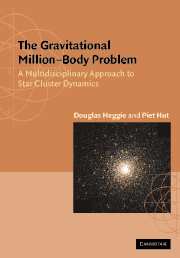Book contents
- Frontmatter
- Contents
- Preface
- PART I INTRODUCTIONS
- PART II THE CONTINUUM LIMIT: N → ∞
- 5 Paradoxical Thermodynamics
- 6 Statistical Mechanics
- 7 Motion in a Central Potential
- 8 Some Equilibrium Models
- 9 Methods
- PART III MEAN FIELD DYNAMICS: N = 106
- PART IV MICROPHYSICS: N = 2
- PART V GRAVOTHERMODYNAMICS: N = 106
- PART VI GRAVITATIONAL SCATTERING: N = 3
- PART VII PRIMORDIAL BINARIES: N = 4
- PART VIII POST-COLLAPSE EVOLUTION: N = 106
- PART IX STAR CLUSTER ECOLOGY
- Appendix A A Simple N-Body Integrator
- Appendix B Hints to Solution of Problems
- References
- Index
6 - Statistical Mechanics
Published online by Cambridge University Press: 05 June 2012
- Frontmatter
- Contents
- Preface
- PART I INTRODUCTIONS
- PART II THE CONTINUUM LIMIT: N → ∞
- 5 Paradoxical Thermodynamics
- 6 Statistical Mechanics
- 7 Motion in a Central Potential
- 8 Some Equilibrium Models
- 9 Methods
- PART III MEAN FIELD DYNAMICS: N = 106
- PART IV MICROPHYSICS: N = 2
- PART V GRAVOTHERMODYNAMICS: N = 106
- PART VI GRAVITATIONAL SCATTERING: N = 3
- PART VII PRIMORDIAL BINARIES: N = 4
- PART VIII POST-COLLAPSE EVOLUTION: N = 106
- PART IX STAR CLUSTER ECOLOGY
- Appendix A A Simple N-Body Integrator
- Appendix B Hints to Solution of Problems
- References
- Index
Summary
In order to progress from qualitative arguments and toy models it is necessary to set up apparatus for describing a gravitational N-body system. There are several ways in which this can be done.
One common approach is to employ the N position vectors ri and the N velocity vectors vi of the stars at some time. Each of these vectors has three components, and so the entire system can be described by a single 6N-dimensional vector, i.e. a single point in a 6N-dimensional space Г. This is a useful description, because it is sufficient to specify uniquely the entire subsequent evolution of the system, as the equations of motion are of second order; they describe the motion of this point through Г. Implicitly, therefore, this is the description adopted in N-body methods, even though it is more natural to think of N particles moving in a six-dimensional phase space.
This description in a 6N-dimensional space can be turned into a statistical one if we imagine a collection of stellar systems, each described by a distinct point in Г. If their distribution is described by a probability density function f, the evolution of f is determined by the equations of motion, and indeed is equivalent to them. This description is almost never used in stellar dynamics.
Another way of describing a stellar system is to represent each star by a single point in a six-dimensional space with coordinates r and v.
- Type
- Chapter
- Information
- The Gravitational Million–Body ProblemA Multidisciplinary Approach to Star Cluster Dynamics, pp. 49 - 57Publisher: Cambridge University PressPrint publication year: 2003



